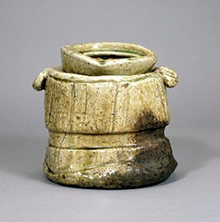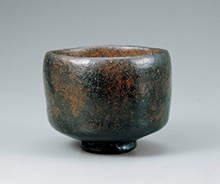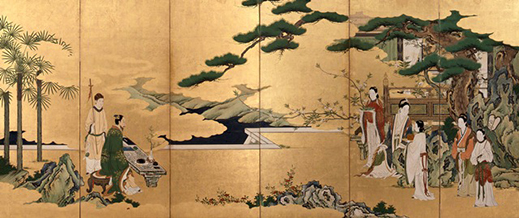 |
|
Here and There introduces art, artists, galleries and museums around Japan that non-Japanese readers and first-time visitors may find of particular interest. The writer claims no art expertise, just a subjective viewpoint acquired over many years' residence in Japan.
|
|
 |
|
|
 |
 |
Never a Dull Moment: Momoyama Art at the Idemitsu
Alan Gleason |
 |
|
Hasegawa Tohaku (1539-1610), Cranes and Bamboo (detail), pair of six-fold screens, late 16th century (on view from 8 September). |
The Momoyama period is hard to pin down. Scholars differ over when it started -- with Oda Nobunaga's entry into Kyoto in 1568, or his overthrow of the last Ashikaga shogun in 1573? -- and ended -- with Toyotomi Hideyoshi's death in 1598, or the Battle of Sekigahara in 1600? Tokugawa Ieyasu's founding of a new shogunate at Edo in 1603, or the fall of Osaka Castle and the last of the Toyotomis in 1615?
|
 |
|
|
|
Water jar, Iga ware, late 16th - early 17th century.
|
All agree, though, that the Momoyama was nasty, brutal, and short. Granted, Nobunaga and Hideyoshi put an end to a century of anarchy and civil war by asserting their control over much of the country, paving the way for two centuries of unprecedented stability under the Tokugawas. Yet both warlords were also legendary for their cruelty and caprice. No one was safe. Nobunaga cultivated Christians; Hideyoshi crucified them. Both men made and broke alliances on whim. The tea master Sen no Rikyu revolutionized Japanese aesthetics under Nobunaga's and then Hideyoshi's patronage; within a few years he was dead, forced by Hideyoshi to commit ritual seppuku over some obscure falling-out that historians speculate about to this day.
Even the name of the era invites dispute. Momoyama is the name of the castle Hideyoshi built in Kyoto -- but what of his predecessor Nobunaga and his stupendous, if short-lived, Azuchi Castle? Some refer to the period as "Azuchi-Momoyama," but that's a bit of a mouthful. Besides, Nobunaga was assassinated only three years after completing Azuchi, and his enemies destroyed the castle.
Just as slippery is any attempt to identify clear trends in the arts during this period. Still, at least two somewhat paradoxical developments appear to have taken place. And though I'm no fan of the "great man" theory of history, the tastes of the two warlords who dominated the era seem to explain much of the art that flourished during their reigns.
One development was an explosion of lavish, decorative art, the antithesis of the Ashikaga penchant for contemplative Chinese-style landscapes in sumi ink. Lots of gold on everything. Big byobu screens with glorious paintings in every room. Nobunaga and Hideyoshi led the way, building luxurious castles that they furnished from top to bottom with monumental works by painters of the Kano school, which thrived under their patronage.
|
 |
|
|
|
Water jar, Bizen ware, late 16th - early 17th century. |
But a countervailing tendency toward subdued, monochromatic austerity also thrived, thanks in large part to Sen no Rikyu's brilliant ritualization of the tea ceremony -- a pastime championed by both Nobunaga and Hideyoshi -- as an exercise in self-restraint. The painter Hasegawa Tohaku, too, was known for sumi-ink landscapes, which, while bolder and livelier than those favored by the Ashikagas, stood in pointed contrast to the gilded excesses of his Kano-school rivals. When Kano patriarch Eitoku died in 1990, Tohaku became Hideyoshi's favorite -- and unlike Rikyu, managed to outlive his patron and move to Edo at Ieyasu's invitation.
|
 |
|
|
|
Chojiro (??-1589), tea bowl known as "Kuromen Okina," Kuroraku ware. |
Rikyu's most lasting influence was probably on Japanese ceramics. Extolling the virtues of wabi and sabi -- variously described, in definitions that often overlap, as rustic simplicity, impermanence, imperfection, the patina of age -- he inspired the production of tea bowls in which cracks, blobs of glaze, lopsided rims and other irregularities were treated as emblems of artistic and spiritual integrity. The wabi-sabi aesthetic survives today in the "Zen" elements that attract Westerners to so many things Japanese.
Hasegawa Tohaku (1539-1610), Crows on Pine and Egrets on Willow (right screen), pair of six-fold screens, late 16th century (on view through 6 September). |
The Idemitsu Museum of Arts in downtown Tokyo has made a gallant effort to present a coherent overview of these conflicting aspects of Momoyama art. Energy and Revival: The Art of Momoyama, on display until 12 October, offers just enough material to give one a sense of the diverse cultural streams that flowed, intertwined, and collided during those few tumultuous decades. Comprising some 100 items from the museum's permanent collection, the show is by no means comprehensive, but it offers everything from screens by Tohaku and members of the Kano school to ceramics from Rikyu-influenced kiln centers like Bizen and Iga, as well as by Raku Chojiro, Rikyu's protégé and the progenitor of Raku ware.
Where the exhibition falls short is in providing sufficient historical context for these developments. Where did the Kanos get their ideas? Was Tohaku consciously rebelling against them? How did Rikyu come up with wabi-sabi, and why was he so successful in imposing his tastes on potters throughout the land? Why did bitter green tea, and the contemplative worldview associated with it, enjoy the favor of these rapacious warlords, even as they were spending their victory spoils on the world's biggest interior-decoration binge?
 |
|
Kano Mitsunobu (1561/65-1608), The Queen Mother of the West and Dong Fangshuo, six-fold screen, early 17th century (on view through 6 September). |
Unfortunately the writers of the exhibition glosses don't tell us these things. Instead they resort to generalities that veer all too frequently into rote nihonjin-ron territory -- tired clichés about the intrinsic and ineffable (i.e., unexamined) uniqueness of Japanese culture. Thus we are told that while cracks and distortion might be considered flaws in ceramics elsewhere, in Japan for some reason they "became incomparable qualities" that were the "essence of Momoyama art." Fine, but how did this happen?
Also glaring in its omission is any acknowledgement that the Momoyama was hardly an insular epoch, but one of intense interaction with the Western world. Indeed, this was the brief interlude when Japan opened its doors to European imports ranging from religion to cuisine to weaponry -- Nobunaga in particular is famous for making the gun a staple of Japanese warfare -- before the Tokugawas slammed them shut again. Yet nothing is said of Nanban art, the genre of painting influenced by these Western contacts that had its heyday during the Momoyama.
Such shortcomings aside, the exhibition provides a pleasantly succinct introduction to a fascinating era in Japanese art, nicely augmented by the panoramic view across the moat to the Imperial Palace through the museum's plate-glass windows.
 |
|
Kano school, Gion Festival (left screen), pair of six-fold screens, early 17th century, Important Cultural Property (on view from 8 September).
All images are courtesy of the Idemitsu Museum of Arts.
|
 |
|
| |
9F Teigeki Bldg., 3-1-1 Marunouchi, Chiyoda-ku, Tokyo
Phone: 03-5777-8600
Hours: 10 a.m. - 5 p.m. (7 p.m. Fridays) (last entry 30 minutes before closing)
Closed Mondays (except open 21 September and 12 October)
Access: 5 minutes' walk from JR Yurakucho Station, Kokusai Forum exit; 3 minutes' walk from subway exit B3, Yurakucho Station (Tokyo Metro Yurakucho Line) or Hibiya Station (Toei Mita Line, Tokyo Metro Hibiya and Chiyoda Lines) |
|
|
| |
 |
Alan Gleason
Alan Gleason is a translator, editor and writer based in Tokyo, where he has lived for 30 years. In addition to writing about the Japanese art scene he has edited and translated works on Japanese theater (from kabuki to the avant-garde) and music (both traditional and contemporary). |
|
|
|
|
|
|
|
|
|
 |
|